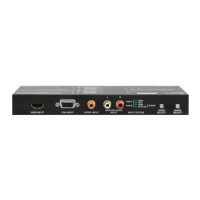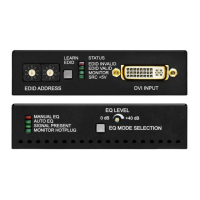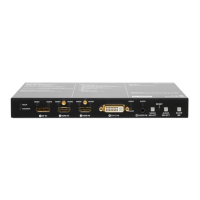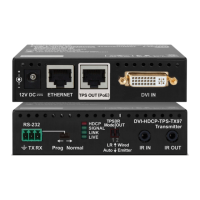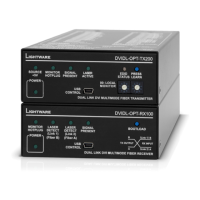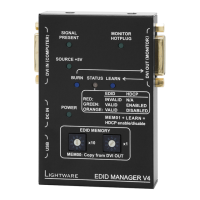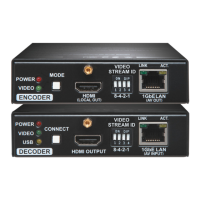UMX-OPT-TX150R
User’s Manual
Section 10. Programmers reference Page 79 / 107
Each number represents the EDID validity state for the corresponding memory location.
Explanation: There is one ‘3’ in the first row on the 1
st
position. This means that the user
EDID is changed since the last EDID query on that port.
Info: If a changed EDID is queried by the {WH} command (see the next section), its value
returns to ‘1’.
Info: EDID deleting means the universal EDID will be uploaded to the deleted EDID’s place.
10.5.4. View EDID header
Description: Shows basic information about EDIDs in the memory.
(EH#<loc>●
<EDID_HEADER>)CrLf
(EH#E1 LWR 1920x1080@60Hz
Univ_HDMI_DC)CrLf
Legend: Depending on <loc> the query can be for one EDID, all EDID in the block.
headers for all (20) Factory EDIDs
headers for all (16) user EDIDs
header from the output (1)
headers from all the four inputs (4)
<EDID_HEADER> consists of 3 fields separated by spaces:
PNPID code The three letter abbreviation of the manufacturer
Preferred resolution The resolution and refresh rate stored in the preferred detailed
timing block.
Name The name of display device stored in product descriptor.
Explanation: Shows the EDID from the input 1.
10.5.5. Download EDID content from the transmitter
Description: EDID hex bytes can be read directly. The transmitter will issue the whole
content of the EDID present on memory location <loc> (256 bytes).
(EB#<loc>●<B1>
●<B2>●..●<B256>)CrLf
(EB#F1 00 FF FF FF FF FF FF 00 32 F2
00 00 00 .. .. .. 00 92) CrLf
Legend: <B1>..<B256> are space separated hex characters represented in ASCII
format.
Explanation: Full EDID from memory location 1 is downloaded.
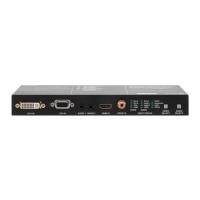
